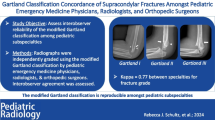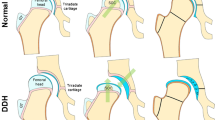Abstract
Objective
To measure the interobserver reliability and intraobserver reproducibility of post total hip arthroplasty (THA) leg length discrepancy (LLD) measurement on radiographs as well as to evaluate its accuracy by comparing it with LLD measurement on computed tomographic scanogram (CT-scanogram).
Materials and methods
In this prospective study, postoperative LLD measurements in ten THA patients were made by four observers on anteroposterior radiographs of the pelvis (inter-teardrop line to the tip of lesser trochanter) and compared to LLD measurements made on CT-scanogram scout views of the lower limb. Two observers repeated the LLD measurements on radiographs 8 weeks after the first measurements. The interobserver reliability of the LLD measurement on plain radiographs was evaluated by comparing the measurements of the four observers and the intraobserver reproducibility by comparing the two repeated measurements made by the two observers.
Results
We found excellent interobserver reliability (mean ICC 0.83) and intraobserver reproducibility (ICC 0.90 and 0.88) of the LLD measurements on plain radiographs. There was a moderate to excellent agreement, but with wide variation of measurements among the four observers, when plain radiographic measurement was compared with CT-scanogram (ICC 0.58, 0.60, 0.71, and 0.82).
Conclusion
Despite the excellent interobserver reliability and intraobserver reproducibility of LLD measurement on radiographs, clinicians should be aware of its limited accuracy when compared to CT-scanogram.


Similar content being viewed by others
References
Konyves A, Bannister GC. The importance of leg length discrepancy after total hip arthroplasty. J Bone Joint Surg Br. 2005;87(2):155–7.
Tanaka R, Shigematsu M, Motooka T, Mawatari M, Hotokebuchi T. Factors influencing the improvement of gait ability after total hip arthroplasty. J Arthroplasty. 2010;25(6):982–5.
Sayed-Noor AS, Sjödén GO. Greater trochanteric pain after total hip arthroplasty: the incidence, clinical outcome and associated factors. Hip Int. 2006;16:202–6.
Hofmann AA, Skrzynski MC. Leg-length inequality and nerve palsy in total hip arthroplasty: a lawyer awaits! Orthopedics. 2000;23:943–4.
Amstutz HC, Ma SM, Jinnah RH, Mai L. Revision of aseptic loose total hip arthroplasties. Clin Orthop Relat Res. 1982;170:21–33.
Sabharwal S, Kumar A. Methods for assessing leg length discrepancy. Clin Orthop Relat Res. 2008;466(12):2910–22.
Clarke GR. Unequal leg length: an accurate method of detection and some clinical results. Rheumatol Phys Med. 1972;11:385–90.
Cleveland RH, Kushner DC, Ogden MC, Herman TE, Kermond W, Correia JA. Determination of leg length discrepancy. A comparison of weight-bearing and supine imaging. Invest Radiol. 1998;23(4):301–4.
Lampe HH, Swierstra BA, Diepstraten FM. Measurement of limb length inequality. Comparison of clinical methods with orthoradiography in 190 children. Acta Orthop Scand. 1996;67(3):242–4.
Terry MA, Winell JJ, Green DW, Schneider R, Peterson M, Marx RG, et al. Measurement variance in limb length discrepancy: clinical and radiographic assessment of interobserver and intraobserver variability. J Pediatr Orthop. 2005;25(2):197–201.
Meermans G, Malik A, Witt J, Haddad F. Preoperative radiographic assessment of limb-length discrepancy in total hip arthroplasty. Clin Orthop Rel Res 2010 [Epub ahead of print]. doi: 10.1007/s11999-010-1588-x
Kogutt MS. Computed radiographic imaging: use in low-dose leg length radiography. AJR Am J Roentgenol. 1987;148:1205–6.
Huurman WW, Jacobsen FS, Anderson JC, Chu WK. Limb-length discrepancy measured with computerized axial tomographic equipment. J Bone Joint Surg Am. 1987;69:699–705.
Poutawera V, Stott NS. The reliability of computed tomography scanograms in the measurement of limb length discrepancy. J Pediatr Orthop B. 2010;19:42–6.
Leitzes AH, Potter HG, Amaral T, Marx RG, Lyman S, Widmann RF. Reliability and accuracy of MRI scanogram in the evaluation of limb length discrepancy. J Pediatr Orthop. 2005;25(6):747–9.
Horneij E, Holmström E, Hemborg B, Isberg PE, Ekdahl C. Inter-rater reliability and between-days repeatability of eight physical performance tests. Adv Physiother. 2002;4:146–60.
Rheault W, Albright B, Byers C, Franta M, Johnson A, Skowronek M, et al. Intertester reliability of the cervical range of motion device. J Orthop Sports Phys Ther. 1992;15:147–50.
Landis JR, Koch GG. The measurement of observer agreement for categorical data. Biometrics. 1977;33:159–74.
Lindell O, Eriksson L, Strender L-E. The reliability of a 10-test package for patients with prolonged back and neck pain: could an examiner without formal medical education be used without loss of quality? A methodological study. BMC Musculoskelet Disord. 2007;8:31.
Woolson ST, Hartford JM, Sawyer A. Results of a method of leg-length equalization for patients undergoing primary total hip replacement. J Arthroplasty 1999;14:159–164
White TO, Dougall TW. Arthroplasty of the hip. Leg length is not important. J Bone Joint Surg Br. 2002;84:335–8.
Goodman SB, Adler SJ, Fyhrie DP, Schurman DJ. The acetabular teardrop and its relevance to acetabular migration. Clin Orthop 1988;236:199–204
Audigé L, Bandari M, Kellman J. How reliable are reliability studies of fracture classifications? A systematic review of their methodologies. Acta Orthop Scand. 2004;75:184–94.
Slongo T, Audigé L, Lutz N, Frick S, Schmittenbecher P, Hunter J, et al. Documentation of fracture severity with the AO classification of pediatric long-bone fractures. Acta Orthop. 2007;78:247–53.
Conflict of interest
The authors declare that they have no conflict of interest.
Author information
Authors and Affiliations
Corresponding author
Rights and permissions
About this article
Cite this article
Kjellberg, M., Al-Amiry, B., Englund, E. et al. Measurement of leg length discrepancy after total hip arthroplasty. The reliability of a plain radiographic method compared to CT-scanogram. Skeletal Radiol 41, 187–191 (2012). https://doi.org/10.1007/s00256-011-1166-7
Received:
Revised:
Accepted:
Published:
Issue Date:
DOI: https://doi.org/10.1007/s00256-011-1166-7




